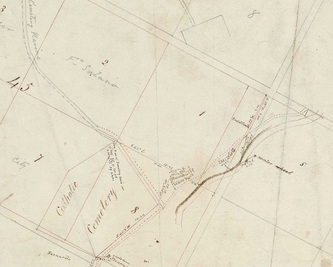|
The water wheel on la Zanja Madre: Part 2 In Part 1 of Where was the water wheel?, we said that the water wheel was located near the bottom of Solano Avenue. How do we know that? In 1868, Capt. William Moore, a Los Angeles surveyor, ran a survey to the center of the water wheel. His field notes, copied onto his map of the survey, are explicit enough that we could follow them today. This is a portion of the map that Capt. Moore produced from that survey, which showed City donation lots, the Catholic cemetery, and la zanja madre. In addition, he surveyed the location of the center of the water wheel. Francisco Solano's 87 acres are also shown on the map. Moore wrote extensive field notes directly on the map; his notes for locating the water wheel are shown below. Moore's field notes will not have any real meaning to anyone who is not familiar with surveying; they are presented here as evidence for the claim that the exact location of the water wheel is known with certainty. The location of the water wheel is pinpointed on this satellite image of the area today: Running nearly vertically through the center of the image is the Solano Canyon community, bisected by the Pasadena Freeway, CA-110. To the left is Solano Canyon's hulking neighbor, Dodger Stadium. And to the bottom right, at the blue pin, is the location of the water wheel, just over the embankment at the bottom of Solano Avenue on the edge of the Los Angeles Historic State Park.
Part 3 of this blog will explore the recent rediscovery of la zanja madre and how a new, modern, fully-functioning water wheel, designed by Metabolic Studio's Lauren Bon, will be incorporated into the plan for the Los Angeles Historic State Park. |
About the AuthorLawrence Bouett is a retired research scientist and registered professional engineer who now conducts historical and genealogical research full-time. A ninth-generation Californian, his primary historical research interests are Los Angeles in general and the Stone Quarry Hills in particular. His ancestors arrived in California with Portolá in 1769 and came to Los Angeles from Mission San Gabriel with the pobladores on September 4, 1781. Lawrence Bouett may be contacted directly here.
Archives
July 2018
Categories |




 RSS Feed
RSS Feed
